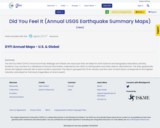
Conditional Remix & Share Permitted
CC BY-NC
The Did You Feel It (DYFI) Annual Summary Webage and Viewer are resources that are ideal for Earth Science and Geography laboratiory activitiy.
Students may connect to a database of factual information collected by the USGS on Earthquakes and other seismic disturbances.
The data graphically shows the highest intensity felt at each location searched. The data is grouped into 10 km blocks, and the color of each block corresponds to the highest intensity calculated for that block (regardless of which event).
- Subject:
- Earth Resources
- Earth and Space Systems
- Geography
- History/Social Sciences
- Science
- Material Type:
- Activity/Lab
- Date Added:
- 07/18/2019